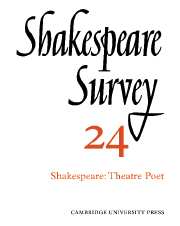Book contents
- Frontmatter
- Hearing Shakespeare: Sound and Meaning in ‘Antony and Cleopatra’
- ‘More Pregnantly Than Words’: Some Uses and Limitations of Visual Symbolism
- Shakespeare and the Limits of Language
- Revenge, Retribution, and Reconciliation
- Shakespeare the Professional
- Shakespeare’s Talking Animals
- The Morality of ‘Love’s Labour’s Lost’
- Shakespeare’s ‘Earth-treading Stars’: the Image of the Masque in ‘Romeo and Juliet’
- ‘Hamlet’ and the ‘Sparing Discoverie’
- ‘Hamlet’ in France 200 Years Ago
- The Hamlet in Henry Adams
- ‘Pericles’ and the Dream of Immortality
- A Necessary Theatre: The Royal Shakespeare Season 1970 Reviewed
- Free Shakespeare
- The Year's Contributions to Shakespearian Study 1 Critical Studies
- 2 Shakespeare’s Life, Times, and Stage
- 3 Textual Studies
- Index
- Plate section
Hearing Shakespeare: Sound and Meaning in ‘Antony and Cleopatra’
Published online by Cambridge University Press: 28 March 2007
- Frontmatter
- Hearing Shakespeare: Sound and Meaning in ‘Antony and Cleopatra’
- ‘More Pregnantly Than Words’: Some Uses and Limitations of Visual Symbolism
- Shakespeare and the Limits of Language
- Revenge, Retribution, and Reconciliation
- Shakespeare the Professional
- Shakespeare’s Talking Animals
- The Morality of ‘Love’s Labour’s Lost’
- Shakespeare’s ‘Earth-treading Stars’: the Image of the Masque in ‘Romeo and Juliet’
- ‘Hamlet’ and the ‘Sparing Discoverie’
- ‘Hamlet’ in France 200 Years Ago
- The Hamlet in Henry Adams
- ‘Pericles’ and the Dream of Immortality
- A Necessary Theatre: The Royal Shakespeare Season 1970 Reviewed
- Free Shakespeare
- The Year's Contributions to Shakespearian Study 1 Critical Studies
- 2 Shakespeare’s Life, Times, and Stage
- 3 Textual Studies
- Index
- Plate section
Summary
Shakespeare the theater poet was certainly writing his lines to be heard – as spoken by actors with appropriate intonation, pace, rhythm and volume. Yet when one seeks to hear Antony and Cleopatra in one’s mind’s ear one finds remarkably little help from commentators. Bradley and Wilson Knight have several fine paragraphs each on the overall tone of the play. Granville-Barker has a valuable page on the range of tones that Cleopatra deploys. Now and again a critical interpreter will follow the changing tones and rhythms of a scene or episode. Editors occasionally suggest the manner in which they think a word or speech should be spoken. But the upshot of this commentary is incidental and fragmentary. Nowhere in print is there a sustained effort to hear the whole play.
Why this neglect? One reason is that the commentators' interest has been elsewhere. In their search for Shakespeare's meanings, scholars have focused either on the very small areas of glossing words and phrases or on the very large areas of tracing themes which extend through the whole play. It is quite possible, though risky, to deal with these matters tonelessly, not 'hearing' the lines at all but merely gathering their bare gist. It is in the middle-sized areas of meaning-of speeches and groups of speeches - that matters of tone are most important. These too have been relatively neglected.
- Type
- Chapter
- Information
- Shakespeare Survey , pp. 1 - 12Publisher: Cambridge University PressPrint publication year: 1971



